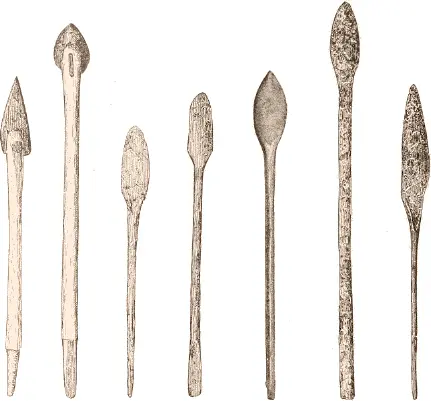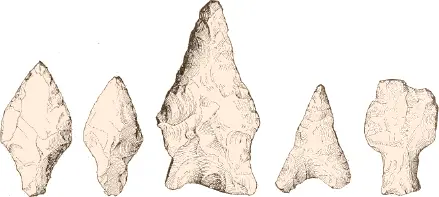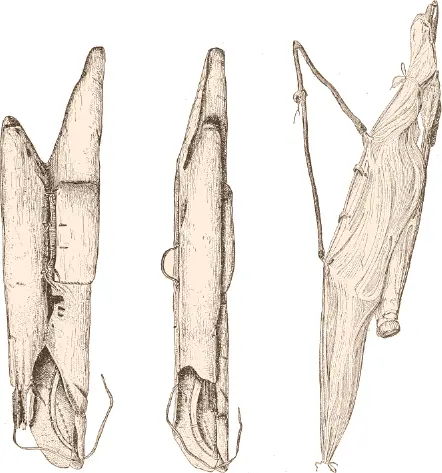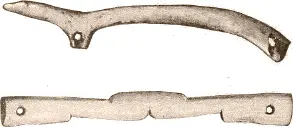
Fig. 446. Various forms of arrowhead. (National Museum, Washington. a , 29993; e , 10213.) ½
The arrows (qaqdjung) are made of round pieces of wood generally tapering a little towards the lower end, to which two feathers of an owl or some other bird are attached. The bone heads of these arrows are joined to the shaft as represented in Fig. 442, while metal heads are inserted as shown in Fig. 443. The difference in the methods used by the Mackenzie and the central tribes in fastening the point to the shaft is very striking. The arrow point of the former and of the western tribes is pointed and inserted in the shaft (Fig. 444), 5while that of the latter is always slanted and lashed to it (Figs. 442 and 443). The direction of the slant is either parallel or vertical to the edge (Fig. 445). Other forms of arrows are shown in Fig. 446. A similar difference between the fastenings of the socket to the spear handle exists in the two localities. The western tribes give its base the form of a wedge (Fig. 447), which is inserted in the shaft, while the Central Eskimo use a mortise.

Fig. 447. Socket of spear handle from Alaska. (National Museum, Washington. 36060.) ¼

Fig. 448. Slate arrowhead. (National Museum, Washington. 10403.) 1/1
Formerly slate heads were in general use (Fig. 448); now the heads are almost everywhere made of iron or tin, riveted or tied to the point (Fig. 446). In ancient graves flint heads are frequently found, some of which are represented in Fig. 449. On Southampton Island stone heads are in use even at the present time. Fig. 423probably shows how they were attached to the shank.

Fig. 449. Flint arrowheads from old graves. (National Museum, Washington. c , 30109; d , 34138.) 1/1
The quiver (Fig. 450) is made of sealskin, the hair of which is removed. It comprises three divisions, a larger one containing the bow and a smaller one containing four or six arrows, the head directed toward the lower end of the case. When extracted from the quiver they are ready for use. Between the two compartments there is also a small pouch, in which tools and extra arrowheads are carried.

Fig. 450. Various styles of quiver. a , b Two views of a quiver from Cumberland Sound. (National Museum, Washington. 30015.) c Quiver from Iglulik (from Parry II, p. 550).
When traveling the Eskimo carry the quiver by an ivory handle; when in use it is hung over the left shoulder. Fig. 451 represents quiver handles, the first being fashioned in imitation of an ermine.

Fig. 451. Quiver handles. (Museum für Völkerkunde, Berlin. a , b , IV A 6843.)
If the deer cannot be driven into the water the Eskimo either stalk them or shoot them from a stand. In a plain where the hunter cannot hide himself it is easier to approach the herd if two men hunt together. They advance, the second man hiding behind the first one by stooping a little. The bows or the guns are carried on the shoulders so as to resemble the antlers of a deer. The men imitate their grunting and approach slowly, now stopping and stooping, now advancing. If the deer look about suspiciously they sit down, the second man lying almost flat on the ground, and both, at some distance off, greatly resemble the animals themselves. Ross (II, p. 252) states that the inhabitants of Boothia imitate the appearance of the deer, the foremost of two men stalking a herd bearing a deer’s head upon his own.
It is somewhat difficult to approach the deer near enough to get within range, especially if they are hunted with bow and arrow. Generally it is not necessary to get quite near them, for when feeding the herd moves on in the same direction for some time, and the hunter can hide behind a stone lying in that direction and wait until they are within range. After the first shot has been fired they do not take to flight at once, but stand for a few seconds, struck with surprise, and a clever hunter may kill two or three before they run away. If the country is very level the Eskimo raise heaps of stones or build circular or semicircular walls to conceal themselves and allure the animals by grunting. As the deer possess a very fine scent they must always be approached from the lee side.
An interesting method of hunting is described by Parry (II, p. 512) and confirmed by Hall (II, p. 178). Parry writes:
Two men walk directly from the deer they wish to kill, when the animal almost always follows them. As soon as they arrive at a large stone, one of the men hides behind it with his bow, while the other continuing to walk on soon leads the deer within range of his companion’s arrows.
Hall says that one hunter hides himself behind a stone while the other utters grunting sounds to attract it.
In winter deer are sometimes caught in traps made by digging holes in the snow and covering them with slabs of the same material. Sometimes urine is poured upon and around the trap or salt water ice is placed upon it, in order to allure the deer (Klutschak, p. 131). Having been attracted to the trap they fall through the roof and are speared in the hole.
Wherever the musk ox is found it is eagerly pursued by the Eskimo. Though dogs are of no use in the chase of the nimble deer, they are of great help in hunting this animal. When a track is found the dogs are let loose and soon overtake the herd. The latter form a circle of defense in which they are kept at bay until the hunter approaches. While the dogs continue attacking and dodging, the musk oxen try to hit them with their horns and do not heed the Eskimo, who assails them at close quarters with a lance to which a thong is frequently attached. When an ox is wounded it makes an impetuous attack on the hunter, who dodges to one side. The dogs being at hand again immediately keep it at bay, thus enabling the hunter to let fly another arrow or throw his lance again. Thus the struggle continues until the greater part of the herd is killed. In rare instances an ox dashes out of the circle and escapes from the pack.
Polar bears are hunted in about the same manner as the musk ox. The Eskimo pursue them in light sledges, and when they are near the pursued animal the traces of the most reliable dogs in the team are cut, when they dash forward and bring the bear to bay. As the hunter gets sufficiently near, the last dogs are let loose and the bear is killed with a spear or with bow and arrow. The best season for bear hunting is in March and April, when the bears come up the fjords and bays in pursuit of the young seals. At this season the she bear is accompanied by the cub which was born in February or March. Its skin and flesh are highly prized by the Eskimo. At some places, for instance at Cape Raper and at Cape Kater on Davis Strait, the she bears dig holes in the snow banks, in which they sleep during the winter. The natives seek these holes and kill the bear before it awakes.
Читать дальше


















